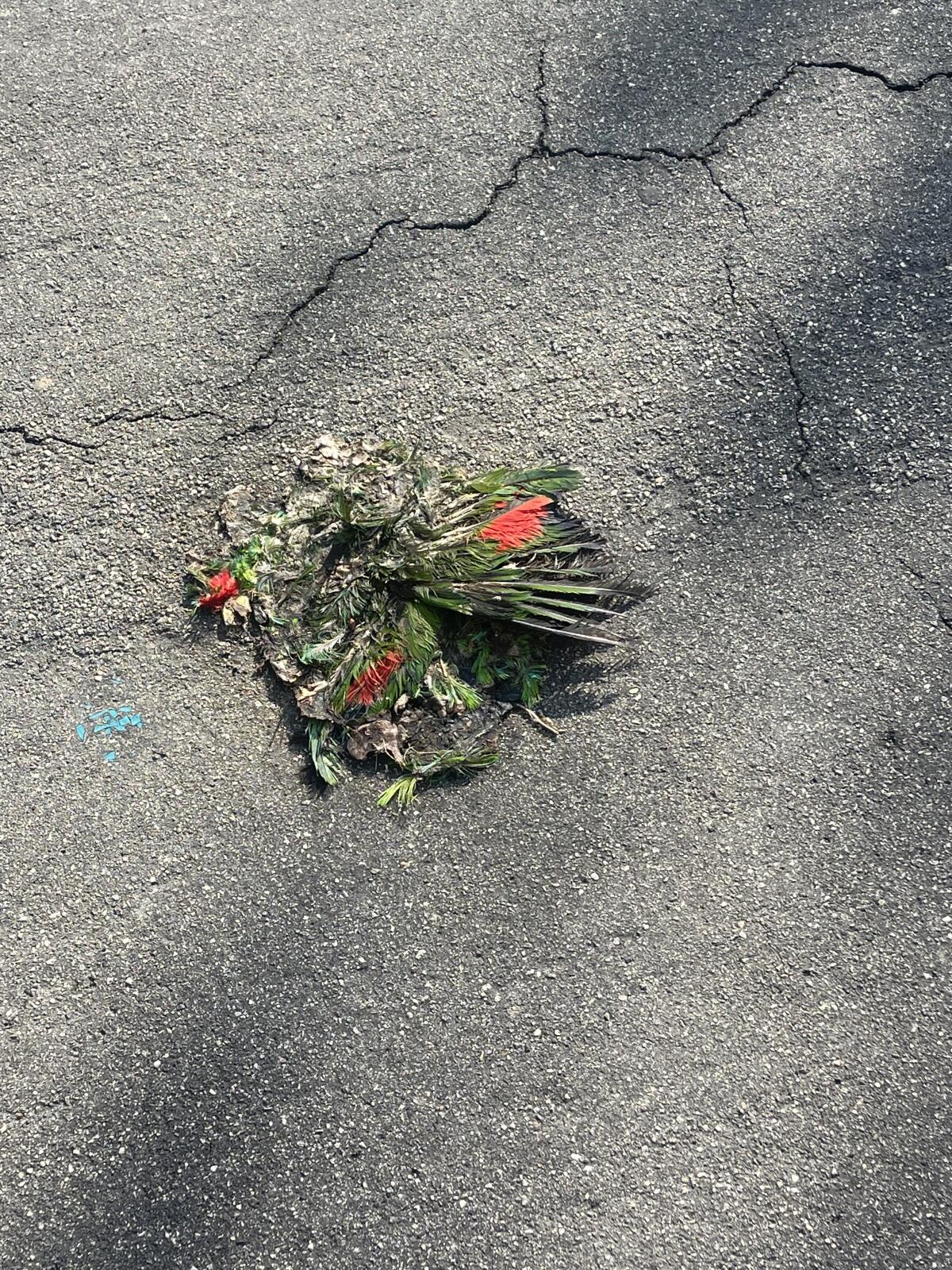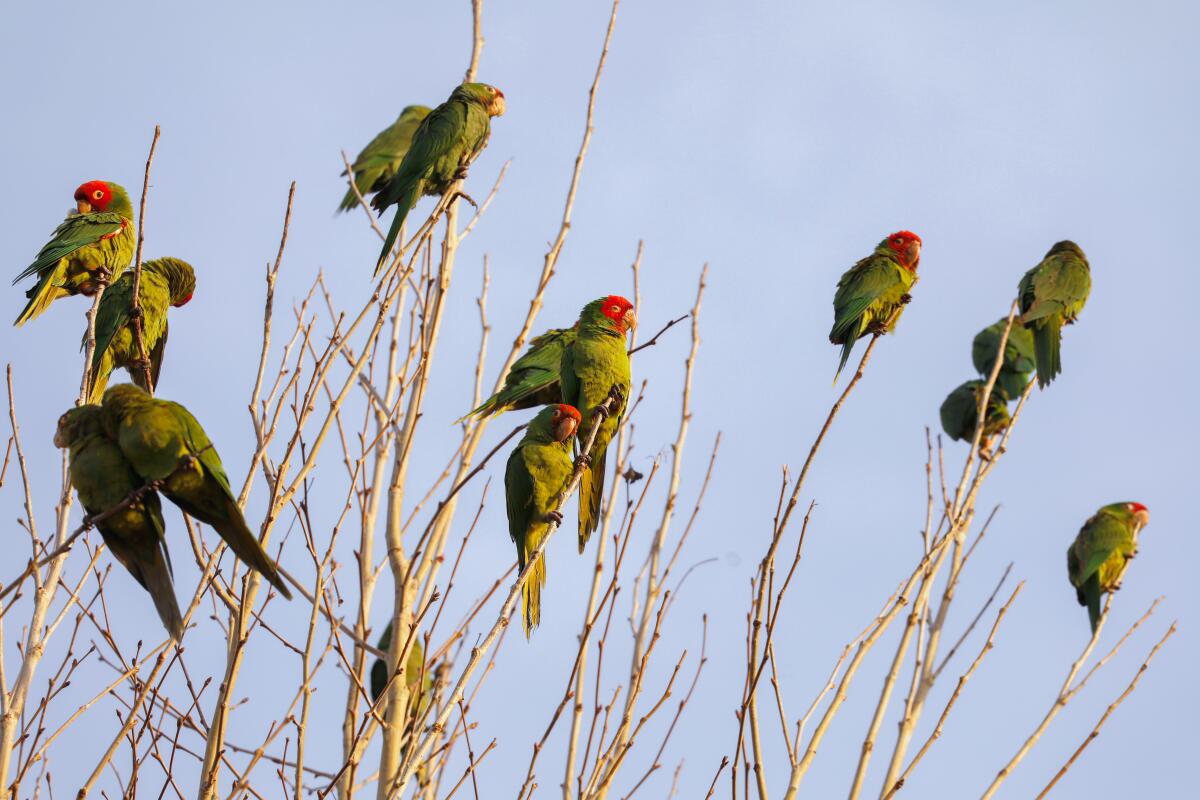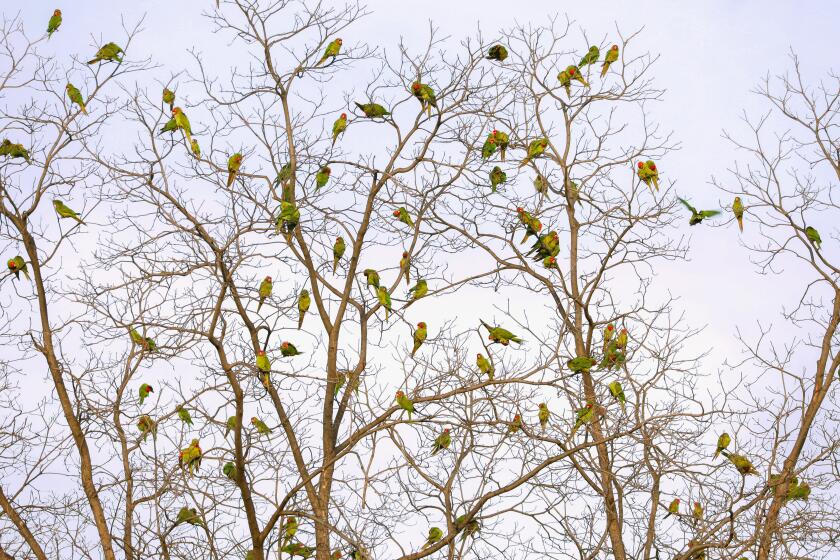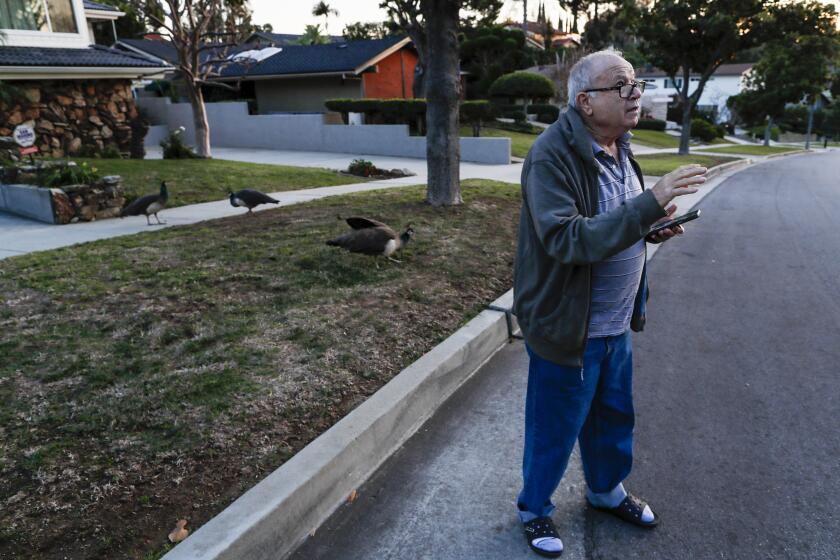Dead parrots offer clues to a poacher lurking in L.A. suburb. ‘It’s just cruelty’
The L.A. County Sheriff’s Department has no leads after video surfaces of a man setting up nets in Temple City and illegally trapping red-crowned amazons.
- Share via
The throaty squeaks of terror could easily be heard from 20 feet away. A pair of green parrots — likely red-crowned amazons native to northeast Mexico — screeched while hanging upside down inside a clear plastic net.
They flapped around, the catches of the day, trapped by an unknown fisher of birds who authorities believe has been illegally rounding up parrots throughout Temple City and perhaps the greater San Gabriel Valley for about a week.
A video captured on Oct. 26 shows a single man pulling down a net nestled amid the city’s leafy London planetrees along Rosemead Boulevard between East Las Tunas Drive and East Broadway. The unidentified man slams the birds against a short concrete wall that he hops over before jumping into his Ford Fusion and driving away.
The video, the nets in the trees and corpses of dead parrots on the ground make it unclear if the man shown in the video is killing all the birds he traps or is taking some of them with him.
It is a mystery that the Los Angeles County Sheriff’s Department acknowledged Friday afternoon it is not close to solving.
“We have an active investigation and have contacted a few people, but we have no person of interest,” said sheriff’s spokesperson Sgt. Erin Liu, who is based out of the Temple City sheriff’s station. “We are still looking.”
Liu said the department was “surprised by the emotion” that has fueled calls and letters to the sheriff’s station, City Hall and other governmental agencies.

San Gabriel resident Ceidy Baker Cordova, 44, said the birds — who have their detractors due to their halting early-morning squawking — are “beloved” in the area, which led to her involvement.
Her husband, Justin Baker, shot the footage as he stopped for coffee around 7:30 a.m. on Oct. 26 while en route to work. Cordova posted the 23-second clip on TikTok, which launched a wave of outrage.
“In the days leading up to that video, we saw the bodies of dead parrots on our walk near where the guy was setting up nets and it was sick,” Cordova said. “Some of them had little ropes around their necks, and we just had to stop this guy.”
Cordova said she reached out to Temple City administrators, the Sheriff’s Department, the San Gabriel Valley Humane Society and California’s Fish and Wildlife Department looking for help.
There are a couple of reasons you might be finding it harder than ever to tune out the squawks, whistles and trills of Los Angeles’ wild parrots.
She hasn’t been able to get any clarity as to who — if anyone — is leading the investigation.
Temple City Mayor William Man did not respond to a call or email seeking comment. Neither did City Council members.
In a statement issued by the city, spokesperson Iliana Flores confirmed that residents alerted city personnel about trapped parrots.
“The City of Temple City is working with the L.A. County Sheriff’s Department to investigate this matter,” the statement read. “City staff surveyed Las Tunas Drive, Rosemead Boulevard and other streets and took down all the nets.”
A spokesperson for the San Gabriel Valley Humane Society also acknowledged that they had received complaints from the public and forwarded all information to the Sheriff’s Department.
Liu said one issue that vexed the department during its investigation was whether trapping the parrots violates any law.
“To be honest, we are learning about the whole situation,” Liu said. “We just can’t arrest somebody without there being a charge.”

After days of back-and-forth consultation with legal experts from California’s Department of Fish and Wildlife, they found a solution: Code 3005.
The misdemeanor prohibits the unlawful taking of “birds or mammals with any net, pound, cage, trap, set line or wire, or poisonous substance, or to possess birds or mammals.”
The birds’ non-native status makes them more difficult to protect, according to retired ornithologist Kimball Garrett, a former collections manager at the Natural History Museum of Los Angeles County.
“Non-native birds are not listed for federal or state protection and so the question comes up of how do conservation agencies protect them,” Garrett said.
South Pasadena voted to remove all peafowl from city limits as the population of the exotic bird has skyrocketed. The move has led to secrecy and split opinion within the community.
Garrett believed the Southern California population was larger than in the bird’s natural habitat of the northern Mexican states of Tamaulipas, San Luis Potosi and Veracruz.
He estimated there were only a few thousand in Mexico along with some red-crowns that live in Texas.
“They’ve been under attack as their habitats have been torn up for agriculture in most cases and also urban development in others,” he said. “Of course, the illegal pet trade has also been fueling their demise too.”
The birds are legally sold online with a price range of $800 to $2,000.
Garrett said the red-crowned amazon is one of several exotic birds that have found a home in Southern California, along with the lilac-crowned parrots of western Mexico and the mitred parakeets of South America. “In some ways, it can be argued that protecting the red-crown amazons here might be their last best hope,” he said.
While there are popular origin myths surrounding the birds’ arrival in Southern California — pet shop fire escapees and abandoned birds from the old Busch Gardens in Van Nuys — Garrett said no single explanation tells the real story.
“It’s a little bit of all of the above with the exception of Busch Gardens, which is not true,” he said. “But it’s possible that the birds you see today are the descendants of escaped pets decades earlier.”

When David Romero moved to East San Gabriel in 1988, one of the first visitors to his home was a red-crowned parrot.
“They’re as much a part of the neighborhood as anyone else,” said Romero, 66. “We’re all parrot fans and we want to see them protected.”
David Nelson, Romero’s partner, said the couple’s Texas umbrella and persimmon trees have attracted a variety of visitors, including yellow-crowned amazons, yellow-chevroned parakeets and other parrots.
“If I can make a prediction, I think the guy is selling them at swap meets,” said Nelson, 76. “They’re worth money.”
The news of the bird abductions hit L.A. County Supervisor Kathryn Barger, a parrot owner, particularly hard.
Barger said she wakes up to see several birds, including red-crowned amazons, “feasting on the red berries” of a hedge inside her yard.
She called amazons and parrots “noble” and said she vowed to check in on the investigation.
“I couldn’t watch the video because it’s just cruelty,” said Barger, whose district includes unincorporated Temple City. “I don’t know what he’s doing with those birds or why he would trap them, but I know we have to stop this.”
More to Read
Sign up for Essential California
The most important California stories and recommendations in your inbox every morning.
You may occasionally receive promotional content from the Los Angeles Times.

















